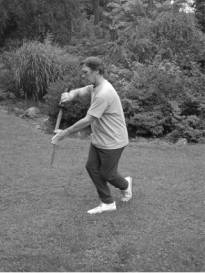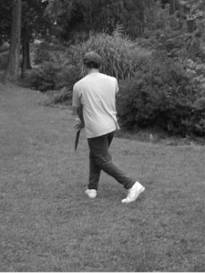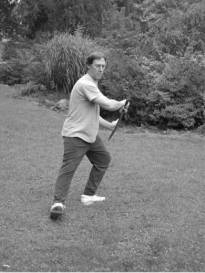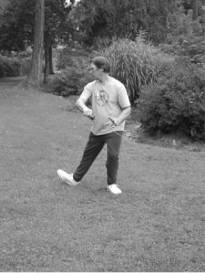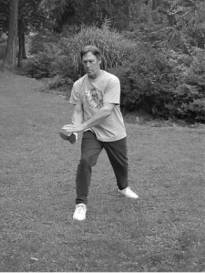 Gilman Studio On-Line Lessons
Gilman Studio On-Line Lessons
Yang Style
Tai Chi Dao/Saber/Broadsword
This Lesson Contains:
Turn Around And Cut Overhand
This is a fun movement. It involves spinning around. I have tried to show it in still pictures, but that is of course impossible. Study the pictures and practice till you get the feeling of a spinning, twisting turn. The opponent thrusts towards my center. I neutralize this to my right, spin past her weapon, and cut her mid section. It is important to spin inward with this movement in order to keep inside the cutting edge of the opponent’s weapon.
 The opponent pokes towards my belly.
The opponent pokes towards my belly.
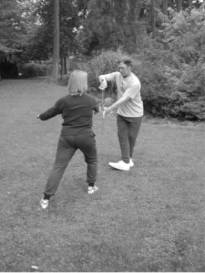
 1) I join and stick to the opponent’s saber while starting to spin around to her closed up side.
1) I join and stick to the opponent’s saber while starting to spin around to her closed up side.
2) Sticking, I continue to make my turn and move in.
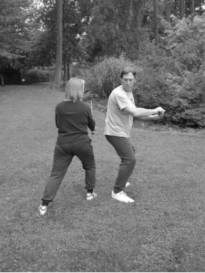
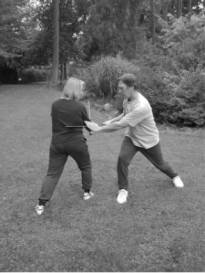 1) I am now past her saber point and start my cut.
1) I am now past her saber point and start my cut.
2) I cut her waist.
Note: It looks like Stephie is just standing there while I cut her. In application, this spinning cut is very quick and takes the opponent by surprise.
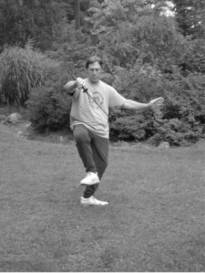
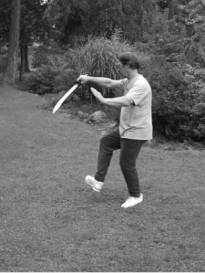 I start to join and neutralize.
I start to join and neutralize.
Sink the weight into the left leg and turn out the right leg as much as is comfortable. It is actually just stepping down at a right angle to the left foot.
The right hand rotates in a counterclockwise direction, dropping the point of the saber down. The side of the saber faces to the right in order to join with the opponent’s incoming thrust. The left hand starts to move towards the saber to give support.
Focus on the side of the saber.
Note: The dropping of the saber point and the putting down of the foot happen at the same time.
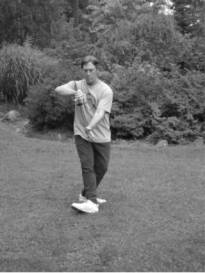
 I join with the opponent’s saber, neutralizing it to my right.
I join with the opponent’s saber, neutralizing it to my right.
Touch down the right heel. The weight stays on the left foot at this time. Notice that the right foot is a bit in front of the left foot. This allows me to move forward past the opponent’s saber. If space is an issue when practicing, you can place the right foot right next to the left foot to save space.
At this point, the saber is hanging straight down on the right side of my body. The side of the blade faces right. Be careful not to bend the right wrist too much or it will weaken the structure. The right forearm, wrist and hand form a fairly straight line parallel to the ground. The left hand has moved to the side of the blade to give stability to the joining and sticking.
Focus on the side of the saber blade. Also, be careful to gently join with the opponent’s blade. If you knock it away you will have no control of what happens next.
Shift the weight onto the right foot and roll up onto the left toe as your torso turns to the right.
The arms remain in the same basic position in front of the right side of the upper body. The opponent’s saber point is now well past me on the right.
Focus on sticking to the opponent’s saber with the side of your saber blade.

 Continuing my turn, I now start my cutting motion.
Continuing my turn, I now start my cutting motion.
The left foot swings or steps around to the right and is placed as far around and behind the right as is possible without losing the root of the right foot. Try not to fall onto the left foot when placing it down. Remember, it is the turning of the torso to the right that allows the stepping to happen. Don’t try and step without turning the torso to the right.
The saber has now moved to the left side of my body. Actually, it stays behind as I continue to turn my torso. It does this in order to continue sticking until I am ready to release the stick and guard to make my own cut.
Focus on the correct placement of the left foot and the sticking with the saber blade.

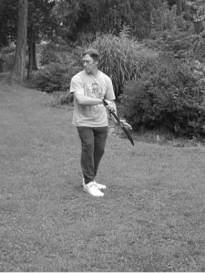 No longer sticking, I get ready for the cut.
No longer sticking, I get ready for the cut.
Continuing to turn the torso to the right, shift the weight onto the left foot and rollup onto the right toe.
The saber is still slightly behind the body. It getting ready for the cut by moving more parallel to the ground. The left hand relaxes, but stays in the same place near the center of the blade. My saber is now hidden from the opponent.
Focus on the target – the opponent’s waist.
Step out with the right foot, just touching down the heel. The toe faces north. Don’t shift the weight yet. Keep some torque in the waist by not turning the torso too much to the right when stepping. Also, be sure to place the right foot wide enough to the right so it can act as a brake for the strong twisting movement to the right and forward.
The saber has moved to the waist level and is now about parallel to the ground. The left hand remains in about the same relationship to the saber.
Focus on the correct placement of the right foot and the target.
Turning the torso to the right, shift the weight onto the right foot until the nose points to the knee.
The saber cuts across the body in an arc like movement and ends on the right side of the right hip. The blade is parallel to the ground. The left hand has moved to cover the right wrist. It could help in the cut by holding onto the right wrist to add strength or it could press on the saber blade to help deepen the cut.
Focus on the cutting edge of the blade.

